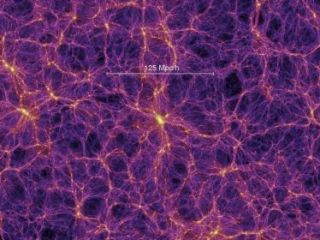Mar 4 2015
The Milky Way, the galaxy that contains our solar system, is located in a remarkable place, lying at the center of a thin plane of galaxies forming a wall between two vast regions devoid of galaxies.
 Galaxies are distributed along a cosmic web in the universe. “Mpc/h” is a unit of galactic distance (1 Mpc/h is more than 3.2 million light-years). IMAGE CREDIT: VOLKER SPRINGEL, VIRGO CONSORTIUM.
Galaxies are distributed along a cosmic web in the universe. “Mpc/h” is a unit of galactic distance (1 Mpc/h is more than 3.2 million light-years). IMAGE CREDIT: VOLKER SPRINGEL, VIRGO CONSORTIUM.
This “anti-Copernican” view of the Milky Way has emerged over time as astronomers attempt to better understand the distribution of galaxies in our cosmic neighborhood.
Miguel Aragón-Calvo, a visiting assistant researcher in the Department of Physics and Astronomy at the University of California, Riverside, will give a free public lecture on campus in which he will discuss the new understanding of the Milky Way. He also will review our current knowledge of the structure of the “cosmic web,” our place in this vast web-like structure comprised of galaxies, and how we live in a place ideally suited for life
Titled “Life at the Edge of a Cosmic Cliff,” the talk will begin at 6 p.m., Thursday, March 5. It will take place in Rooms 205-206, Winston Chung Hall. Parking information can be found here. Parking Lots 10 and 13 are recommended.
“The anti-Copernican view of the Milky Way is this realization that has been growing in the last few years that there is something peculiar about both the Milky Way and its cosmic environment,” Aragón-Calvo said. “The answer seems to be that we are indeed a peculiar galaxy, we seem to be too massive for our cosmic environment compared to theoretical expectations. This is perfectly ok; we expect such “outliers” here and there, but then that may change some of our interpretations of local observations.”
Aragón-Calvo came to UC Riverside in 2013. Before that he was an assistant research scientist at Johns Hopkins University, which is where he also completed his postdoctoral research. He received his doctoral degree from the University of Groningen, Netherlands.
His areas of interest include cosmic web analysis, galaxy formation, and data mining/visualization.
“The cosmic web is a network of matter encompassing all the structures we see,” he said. “Galaxies are organized as a network with dense compact groups joined by bridges and membranes in between. A good analogy, even in its properties, is a foam; sometimes you see the term “cosmic foam” which is more accurate than cosmic web.”
Aragón-Calvo’s talk is the fifth in a series of astronomy talks being held at UCR.